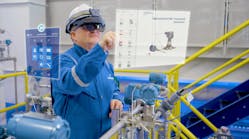Hygienic spray dryer design for processing food ingredients
Infant formula and other powder-based foods requires the strictest food safety and quality standards. To protect against the potential for product contamination by bacteria such as Enterobacter sakazakii and Salmonella, and to meet regulatory requirements for these products, producers must ensure absolute certainty in hygiene and food safety. They must also protect the nutritional value of the product. This encompasses not only assuring the microbial quality of raw materials, but also the hygienic design and maintenance of equipment critical for the processing of these food ingredients. Among the most important of these processes is spray drying, which is depended upon for near final processing — and quality assurance of the powder-based food product — prior to agglomeration, storage and packaging.
Spray drying of food ingredients
As a pivotal process in the manufacture of many infant formulas and other powdered ingredients, spray drying performs a vital product drying function that must maintain the highest levels of cleanliness to support food safety.
In the spray drying process, ingredients are first blended with water in large batches, homogenized and then put through a heat exchanger for pasteurization before spray drying. The pasteurization step destroys harmful bacteria that may be present in the ingredients, heating the product to between 160°F and 200°F. The slurry is then passed through a high-pressure pump into spray dryer nozzles that atomize into the spray dryer where the inlet air temperature ranges from 280°F to 400°F depending on the process requirements.
As the droplets of product pass through the dryer, water is evaporated and the dry powder falls to the bottom of the spray dryer. The warm powder is passed through a fluidized bed, where it is cooled by a stream of chilled air to approximately 70°F, which further dries and cools the product. After spray drying, the product may be agglomerated to increase the particle size and to improve its solubility. The spray dryer effectively exercises complete control over characteristics such as density, moisture content and powder properties. The finished powder is passed through a sifter then transferred to bags, totes or silos for storage, or the powder may be transferred directly to a powder packaging line.
Since pasteurization is performed prior to spray drying, with no further downstream process to ensure decontamination, the spray drying procedure must therefore ensure that no product contamination occurs during the process.
Hygienic spray dryer design
Conventional spray dryers used in food ingredient manufacturing must conform to FDA and National Sanitation Foundation International (NSF) standards, as well as those specified by A-3 Sanitary Standards Inc. Each has a slightly different approach to the task of making equipment safe for food production. But heightened industry requirements for spray dryers — necessitated by the demand from infant formula manufacturers for a higher level of protection from product contamination — have pushed recent spray dryer designs beyond the conventional requirements of FDA, NSF and 3-A Sanitary Standards, and into a higher level of hygienic spray dryer operation.
This initiative has been strongly influenced by the European Hygienic Engineering & Design Group (EHEDG), which prepares scientific and technical guidelines on all aspects of hygienic design requirements for equipment used in the food and pharmaceutical sectors. With a focus on improving product safety, process efficacy and production efficiencies, the latest guidelines from EHEDG recommend that equipment used in the processing of food ingredients for sensitive applications — such as spray dryers — be designed to hygienic standards exceeding conventional 3-A Sanitary Standards, essentially to better ensure the microbiological safety of the end product. Food equipment manufacturers in the United States have been increasingly looking to EHEDG for guidance in manufacturing equipment that more completely meets these escalating hygienic requirements.
EHEDG hygienic design recommendations for spray drying equipment more completely assure cleanability and the elimination of hollow body components that may provide micro-niches for microbial proliferation. This extends to each part, module and unit that makes up the spray drying processing equipment. The physical design of enclosures and surroundings must also be considered as an integral part of the overall hygienic system of the spray dryer. This is because they influence and affect the efficiency and effectiveness of the design, installation, operation and maintenance of hygienic spray drying processes. Validation procedures and hygienic risk assessments therefore include consideration of such matters as cleanability of surfaces, air systems and drains, flow of people and materials and products, and ease of spray dryer process equipment access and maintenance.
Spray dryers for food products in sensitive applications are just now beginning to integrate EHEDG hygienic recommendations into their designs. One such spray dryer, manufactured by Dedert Corporation — a custom-designer of industrial concentration and drying equipment based in Homewood, Illinois — provides an excellent example of this new generation of multi-stage spray dryers that meet stringent EHEDG hygienic design standards. Here is an overview of the system’s key components supporting hygienic processing:
Engineered to eliminate crevices, ledges and dead spots
From the liquid feed system through to the fluidized bed, spray dryers have several hundred feet of piping transporting both slurried and dried food ingredients through valves, strainers, screens, instrument connections, inline tubular heaters, high-pressure nozzles and other equipment. In conformance with EHEDG hygienic standards, the Dedert spray dryer is engineered so that each of these systems — as well as the entire spray dryer itself — is completely free of crevices, ledges and dead spots, so that liquid — either in slurry, condensation or during washdown — is completely drainable with no areas where it can settle.
Surfaces are designed to be convex, rounded or inclined to 45 degrees to actively promote the flow rate of product spillage and cleaning solutions. All tubing is closed-welded, with bolts, studs, mounting plates, brackets, junction boxes, name plates, end caps, sleeves and other such items continuously welded to the surface. All inside surfaces are polished to 0.8 Ra roughness.
Clean-in-place wet cleaning
The spray drying process requires that the equipment, including the spray dryer and fluidized bed, be regularly wet cleaned, specifically during product changeovers. The Dedert spray dryer is equipped with a fully automated clean-in-place (CIP) system to ensure effective and efficient cleaning of the equipment. The CIP system ensures that every product contact surface that is touched by product will also be in contact with cleaning solutions at the proper temperature and flow rate so that all product residues are removed. CIP also avoids time consuming disassembly and reassembly of system components for manual cleaning.
EHEDG hygienic standards require the CIP system to clean, and then drain, every surface area and orifice of the dryer. The Dedert CIP system is designed to eliminate all moisture after cleaning so as not to permit bacterial growth. It utilizes warm, compressed air, which is added to get all liquid drained and out of the spray dryer, leaving the entire spray dryer completely without residual moisture.
Hygienic atomization
Rotary atomization is the most flexible method of controlling feed rate and spray dryer operation, while maintaining the required dry product specifications. Conventional rotary atomization technology, however, uses mechanical bearings, requiring the need for high maintenance of gear drives and shafts, with oil lubrication and cooling systems. Furthermore, these nozzle systems need to be cleanable, drainable and removable. These factors open the possibility of debris or oil getting into the product.
The Dedert spray dryer benefits from the development of a new high-speed rotary atomizer for the food industry. The new design, based on magnetic bearing technology, eliminates the need for high maintenance gear drives, traditional bearings, shafts, oil lubrication and cooling systems. Consequently, this system is a considerably more hygienic design.
Combined with a specially designed atomizing wheel and liquid feed distributor, the hygienic rotary atomizer can accommodate a broad range of liquid feeds.
Hygienic air source
Dry air, HEPA-filtered to 0.3 microns, is supplied to the Dedert spray dryer and fluidized bed to minimize the risk of product cross-contamination and to maintain food safety. The three-stage filtration system is designed for easy-access maintenance and cleaning, and removal and replacement of filters.
Removable-panel, air-gap insulation
Needing to maintain consistent temperatures of 200°F to 400°F, spray dryers are typically designed with internal and external stainless-steel cladding with fiberglass or mineral wool sandwiched between them. Over time, the internal metal surface of the vessel can exhibit cracks, which can permit the insulation to harbor material from processing, along with microbial contamination. In addition to this material being difficult to remove with conventional manual and CIP cleaning techniques, the vessel design does not permit easy access for inspection.
One solution to this problem has been to eliminate the insulation and position the spray dryer in a heated room, a technique that has proven energy inefficient. Another has been to keep the insulation but make the vessel accessible through bolt-on/bolt-off removable panels. An improvement, for sure, but system downtime is considerable — the time to access the entire vessel for inspection or cleaning can take days because of the large number of bolts that need to be taken off and put back on.
The Dedert spray dryer incorporates a new design — removable-panel, air-gap insulation. The design permits the vessel to be inspected through hinged, outer-cladding doors, which can be opened and closed in a fraction of the time compared to bolt-on panels. As the name suggests, there is no fiberglass or mineral wool, instead air is used for insulation between the inner and outer skin of the vessel.
The system permits more frequent inspections and necessary cleaning and repairs to be conducted, which provides a better guarantee of a more hygienic vessel for spray drying.
Hygienic fire protection systems
Drying of ingredient powders presents an explosion risk, and comprehensive safety equipment is required to ensure protection of the plant and personnel. Rupture chambers, vent ducts, firefighting systems, carbon monoxide detection systems and suppression systems are all included in the design of a spray dryer to meet very stringent requirements set forth by NFPA guidelines.
Two newly engineered hygienic fire protection systems have been incorporated into the Dedert spray dryer: a) Hygienic fire protection nozzles that are fully retractable, non-invasive and which can be cleaned; and b) A hygienic explosion vent door protection system that is NFPA-68 compliant. The system has hinged doors that include spring-release latches and dual seals.
Optimized hygienic plant layout
Where special plant conditions and sanitation requirements are known in advance, it is possible to introduce certain design features to ensure hygienic compatibility with other equipment and systems such as electrical, hydraulics, steam, air and water. This represents the big picture for use of hygienic spray dryers in food processing operations, where the hygienic environment extends out from the dryer into the manufacturing facility.
Food processors that use the spray drying process typically partition their plants into wet-process and dry-process areas to limit microbial transportation, and strictly limit the movement of people and equipment between the wet and dry areas. Control of temperature and humidity in the outlining areas can also be executed. And mechanical equipment, such as fans and compressors, should be housed in a separate mechanical equipment room.
The need for heightened hygiene in food ingredient spray dryer performance has been pushed forward by manufacturers of sensitive food products, such as infant formula. That need has been supported by EHEDG, FDA, NSF and other regulatory and standards setting organizations. Although manufacturers are sometimes slow to adapt to industry needs, some spray dryer manufacturers, such as Dedert, have taken the initiative to move forward and integrate these more stringent hygienic recommendations into their spray dryer designs.
Jim McMahon writes on food processing technology.


